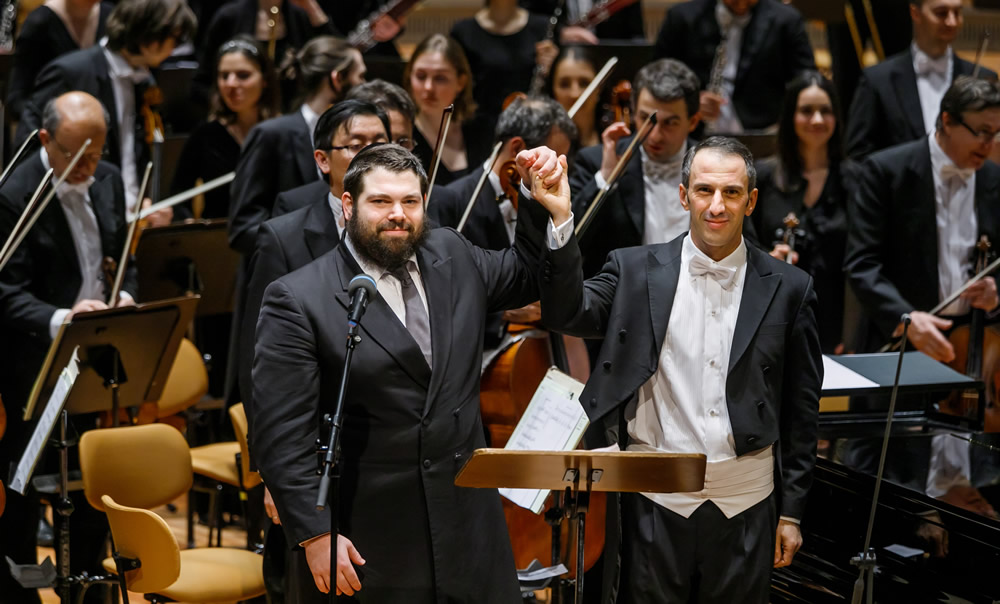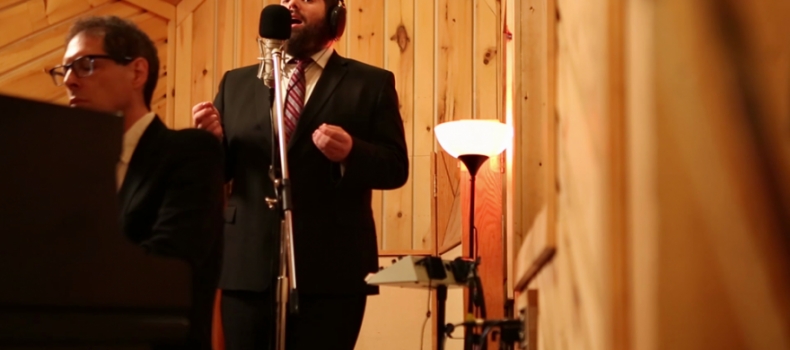Tapping into the ‘Golden Age’ of cantorial music for the 21st century
Ordained Chabad rabbi and cantor Aryeh Leib Hurwitz has traveled the world honing his voice and performing skills, and is now part of an effort to revive the classic tradition of “chazzonus,” the quasi-operatic Jewish music of more than a century ago. Photo: With jazz backup, Cantor Aryeh Leib Hurwitz sings “Sheyibone,” a fundamental Jewish prayer beseeching G-d to rebuild the Beit Hamikdash (Holy Temple), ushering in a period of global unity and harmony. Credit: Courtesy.
Aryeh Leib Hurwitz is attuned to all things musical. A chazzan (“cantor”) and ordained Chabad rabbi born and raised in Brooklyn, N.Y., he studied at yeshivahs around the world while honing his voice and performing skills. The 29-year-old father of nearly 3-year-old twins has been on stage in Berlin and Johannesburg. He has sung before NBA crowds. He can belt out familiar pieces from “Fiddler on the Roof” and “Les Misérables,” croon at weddings and headline a jazz band. And, of course, he sings in synagogue during the High Holidays in the classic tradition of chazzonus, the quasi-operatic Jewish music of more than a century ago—music that transports listeners back to a time before great human sound wasn’t accessible by the click of a button.
Here, he shares a bit about himself and the Eastern European musical tradition that is his hallmark.
Q: Is cantorial music entertainment, spiritual nourishment or both, and how so?
A: In the 19th century, cantorial music was the only form of Jewish entertainment. You looked forward to going to the synagogue to hear your favorite cantor perform, and with that, receive spiritual nourishment. Of course, that changed significantly over the decades, in time and place. Today, cantorial music is an art performed globally on the High Holidays. However, its art is beautiful year-round, and still plays the role of both entertainment and spiritual nourishment in various communities around the globe.
Q: How has cantorial music changed in the past two decades since the turn of the 21st century?
A: The golden age of chazzonus was in the early 1900s. There’s been a major decline since the likes of Josef “Yossele” Rosenblatt, Moishe Oysher, Moshe Koussevitzky and so on. Having said that, since the turn of the century there has been a nice comeback unfolding. With cantorial music now available with the click of a button (YouTube) and people appropriating culture, there are many different occasions where cantorial music is on display.
Q: What is its role in Jewish life?
A: The cantor is the shliach tzibbur, the “representative of the community.” Their job is to pray to the Almighty on their behalf. Cantorial music is the tool that the chazzan uses to spiritually connect the congregant with the God. That’s why it’s largely associated with the High Holidays and life-cycle milestones.
Q: Does cantorial music have a special role during the High Holidays?
A: Yes. It’s the highest of holidays. The time to connect to God makes it all the more essential. On a technical level, the prayers are less known. So it’s important that the quarterback—aka, the cantor—knows the rules, the prayers and the songs.

Q: Is cantorial music meant to affect the worshipper? Does it complement prayer, or is it singular in nature?
A: Cantorial music is based in the essence of nusach ha’tefillah, the “modes of the prayers,” which were passed down generations since the time of the Temple in Jerusalem. There is holiness in the music. When used in its true form, it absolutely affects the worshipper, as it also compliments the prayer.
Q: What is the voice range of a cantor? Are they mostly tenors?
A: Most have been tenors, historically, like the “Cantors of the Golden Age.” I am a tenor. But today, it’s more common to be a baritone … I would say maybe 25 percent of cantors today are baritones. And, of course, within those general definitions are different types and ranges.
Q: What is the difference between the concert chazzan and the synagogue chazzan?
A: Let’s start with the important job of the synagogue chazzan. The chazzan is sincere, humble and with a sweet voice pours his heart out to the Almighty. The concert chazzan can be a true entertainer, or he can be a synagogue cantor giving a concert. Does the music fit with nusach ha’tefillah? Is it a piece that connects one spiritually? Or is it a piece that is a joy to listen to?
The greats did both at a high level.
Q: Do niggunim and cantorial music serve different purposes?
A: Completely. Niggunim is Jewish music meant for everyone to join in and be inspired together. Cantorial niggunim is an art that is best done with the participants silent.
Q: What does music mean to you and your religious life?
A: Music is a tool to connect. Unlike many career musicians, for a religious Jew, music is another form of serving God, whether dance music, classical music or cantorial music.
Q: What are your most memorable moments on stage?
A: My most memorable moments were certainly singing as the very first cantor ever to perform a Jewish song in the main hall of one of the most prestigious halls in the world—the Berliner Philharmonie in Germany, home of the Berlin Philharmonic Orchestra—with a 70-piece orchestra. I was also fortunate enough to perform in three cantorial concerts in Johannesburg, South Africa. And to perform the national anthem, “The Star-Spangled Banner,” before two different NBA games for “Jewish Heritage Night” events: for the Utah Jazz in Salt Lake City and the Brooklyn Nets at the Barclays Center in New York City.
Q: Who is your musical role model?
A: So many … if I had to choose one: Moshe Koussevitzky. He served as a cantor in Vilna and Warsaw, escaping the Nazis with his family during the Holocaust by fleeing to the Soviet Union. They came to the United States in 1947; five years later, he became cantor of Temple Beth-El in Borough Park (Brooklyn). He was one of four brothers, all cantors. In December 1947, they sang together in a concert at Carnegie Hall.
Q: Do strong voices run in families?
A: They certainly can, yes. Parents, siblings, children can all have beautiful voices. I have a brother who’s a wedding singer. I come from a family with musical lines. But it is an art to be studied. The cantorial greats, they worked to refine their voices.
Q: Do you have a favorite music city?
A: Nashville, Tennessee. I have performed a few times there and will be going again. It’s an entire city that has an appreciation of and love for music—all music. I find that fascinating.

